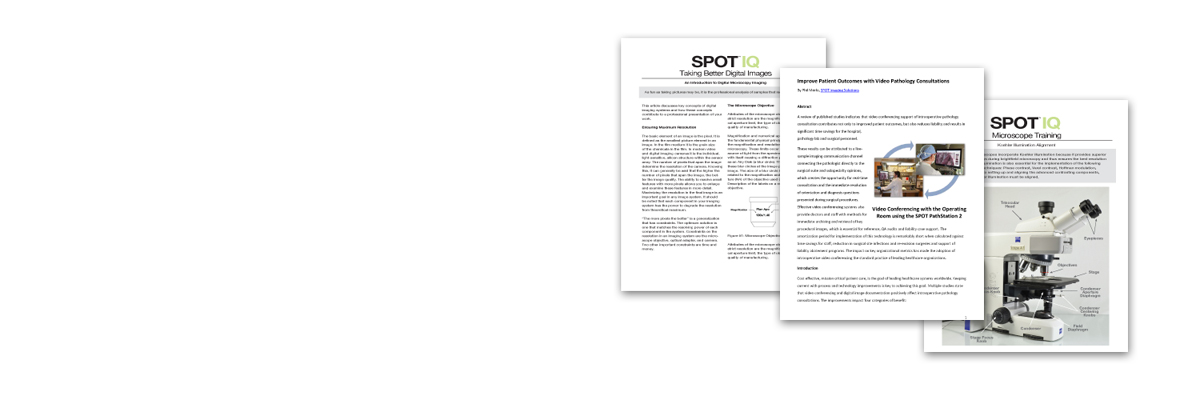How to Improve Color Reproduction in Microscope Images
When you capture an image of a specimen, you want it to look like what you saw through the eyepieces. In this article we will cover the basic concepts of color management and what you can do to make sure what you capture is as close to what you see as possible.
Get a Reference
Let’s define what you want to achieve: you want the image you produce on your computer screen or on the printed page to look like what you see through the eyepieces of your microscope. In order to maximize the match between these images, your system must be setup to use the same reference. White light is the primary reference that you have most control of in your imaging system. It is your responsibility to set it properly at different points in your system.
Many Colors of White
Although “White” sounds like a defined color, there are different shades of white. This happens because white light is made up of all wavelengths in the visible spectrum. True white light has an equal intensity at every wavelength. If any wavelength has a higher intensity than the rest, the light takes on a hue related to the dominant wavelength. A simple definition of the hue cast of white light is called “Color Temperature”. This comes from its basis in the glow of heated materials. In general the lower the temperature (in °Kelvin = C° + 273) the redder the light, the higher the temperature the bluer the light. The one standard white lighting in photography and photomicrography is 5000°K (D50) and is called daylight neutral white. This is a good standard for brightfield imaging since there are readily available methods to achieve this standard throughout your system.
Start at the Source
The light source of your microscope or grossing stand provides the light by which your imaging system will view your specimen. How can you get it to provide 5000°K light? Luckily this is not an uncommon task and your microscope or photo supplier can provide you with a “Daylight Blue Conversion Filter”. These filter are designed to change the color balance of tungsten halogen light in your light source to daylight color temperatures needed for your imaging system. It should be noted that there are a series of daylight blue filters that accommodate different color temperature shifts:
- 80A with mired (MK-1)= -131
- 80B with mired (MK-1)= -112
- 80C with mired (MK-1)= -81
- 80D with mired (MK-1)= -56
The mired (a.k.a. reciprocal megakelvins MK-1) number expresses the color temperature shift provided by each filter. The shift can be calculated by the following formula:
Color Temperature= 1/{(1/Bulb Temperature °K) + (Filter Mired# / 1,000,000)}
Halogen bulbs generally have a 3200°K color temperature since the filaments are typically run at >3000° K and melt at 3400°K. Your lamp manufacturer can provide you with the color temperature of the lamp you are using when run at its rated voltage. Set the Camera The camera now needs to be set to white. This is done by selecting the “White balance” function on your camera while looking at the transmitted light of the microscope with no specimen or for reflected light applications use white paper. This function tries to balance white to a “Neutral Balanced White” by setting the brightness of each of the red, green and blue channels to be equal. In three shot cameras, this is done by balancing the individual exposure times for the red acquire, the green acquire and the blue acquire by the white balance numbers. In color mosaic cameras, the values of each color channel are multiplied by the white balance numbers.
| Filter | Filter Mired | Bulb Temperature | Color Temperature |
|---|---|---|---|
| 80A | -131 | 3100 | 5220 |
| 80B | -112 | 3100 | 4749 |
| 80C | -81 | 3100 | 4139 |
| 80D | -56 | 3100 | 3751 |
| 80A | -131 | 3200 | 5510 |
| 80B | -112 | 3200 | 4988 |
| 80C | -81 | 3200 | 4320 |
| 80D | -56 | 3200 | 3899 |
| 80A | -131 | 3300 | 5813 |
| 80B | -112 | 3300 | 5235 |
| 80C | -81 | 3300 | 4504 |
| 80D | -56 | 3300 | 4048 |
| 80A | -131 | 3400 | 6131 |
| 80B | -112 | 3400 | 5491 |
| 80C | -81 | 3400 | 4692 |
| 80D | -56 | 3400 | 4200 |
Set Your Monitor
If you are going to view images on a computer monitor, you need to standardize the color temperature of the monitor. Most monitors have a minimum of three color-temperature settings: 5000° K, 6500°K and 9300°K. Set your Monitor to the 5000°K (D50) setting.
Paper Output
When printing out your image, one of the most important things you have control over is the paper. The paper’s “whiteness” has a specification called the ISO Brightness. This specification is an internationally standardized measure of the reflectance of light off the paper. Good papers have numbers in the >92% range. It should also be noted that there are papers that have greater than the 100% value since they are actually coated with phosphors that capture UV light and re-emit it in the visible spectrum. These may have color temperatures too high for good color reproduction. Another factor with paper is its coating. Coatings keep the ink from wicking into the paper fibers from where the printer deposited it. This ensures the ink micro-droplet’s final resting place is where the printer intended it. Coatings can be executed in both matte and gloss finishes. Matte finishes are easier to read since they reduce glare, while gloss coatings produce more saturated colors, your intended use and experience lead you in this decision.
Ambient Lighting
Ambient lighting affects your impression of what is white in two ways. The first effect is the psychological reference that it provides you. Since you are totally surrounded by this light your mind likes to set its own “white” reference to this color white and perceive all other white as tinted. The second effect is a biochemical reaction that occurs in the eye. It is related to the depletion of the chemicals in the retina that sense the different colors of the spectrum: red, green and blue. This effect occurs when the blue sensing chemical is depleted in high color temperature light making the eye have a red shifted perception of the world. Conversely, when working in a low color temperature environment the red chemicals will be depleted and the eye will have a blue shifted perception of the world.
What are Examples of Ambient Lighting Conditions Problems?
If your workstation is near a northern set of windows in the northern hemisphere (or southern in the southern hemisphere) the light that is flooding the room on a clear day is 16,000°K and is very blue. This makes everything on in your microscope and on your monitor look “yellow-red”. If you work in a room with just tungsten lighting then your microscope and monitor will look “blue”. So what should you do? You really only need to setup your room to a reference situation when you want to critically review color output or perform macro-photography, during the other times you can enjoy the windows as along as they do not contribute enough light to shift the illumination of your specimens. During the critical color evaluation or macro-photography two setups are possible: The least expensive but possibly annoying is to close the curtains, turn out the lights and let the monitor and microscope/ macrostand illuminator be your white frame of reference. Since this is often impractical, the next best solution is to still close the curtains and purchase a high grade of 5000°K fluorescent light. There are readily available 5000°K Fluorescent bulbs. These fluorescent bulbs mimic the full spectrum light of glowing black body radiators by providing discrete phosphor line spectra through out the spectrum. The higher the grade of bulb the more line spectra are provided and premium grades provide a full compliment of rare earth phosphors. An example part number of this type of bulb is SPX50.
In Review
Color management is a standardized measure of the hue balance of white light. It is a fundamental reference at different points in your imaging system and should be set to a standardized color temperature. The points that you as the user have control over are: the light source filtration, the camera white balance, the monitor color temperature setting, the paper ISO brightness and the ambient lighting source color temperature. A readily attainable color temperature throughout most imaging systems is 5000°K (also known as D50). Use of these basic color temperature settings will improve the fidelity of your images whether they are quick snapshots or publication quality images.

